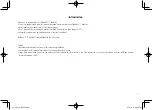
Messages 95
• Creation mode
: allows you to select the MMS creation mode:
Free, Restricted, or Warning.
–
Restricted
: you can only create and submit messages with content
that is supported by the recipient device.
–
Warning
: the phone notifies you when you try to send a message that
may not be supported by the recipient device.
–
Free
: you may add any content to the message.
Push message settings
• Push message
: allows you to receive push messages from the
network.
• Service loading
: allows you to set the type of service loading
notification. Choose from: Always, Prompt, or Never.
Cell broadcast (CB) settings
• CB activation
: allows you to receive Cell Broadcast (CB)
messages.
• Channel configuration
: allows you to set up the channel that you
will receive CB messages on.
• Language
: allows you to select all of the languages that you want
to receive CB messages in.
Notification settings
• Notifications
: allows you to see message notifications on your
status bar.
• Select ringtone
: allows you to set the ringtone for your message
notifications.
Email (or Internet Email) enables you to review and create email
using various email services. You can also receive text message
alerts when you receive an important email. Your phone’s Email
application lets you access and manage multiple email accounts
simultaneously in one convenient location.
There are currently two main types of email accounts on your
phone: Internet-based email (Gmail, Yahoo! Mail, etc.), and
Microsoft Exchange ActiveSync (Corporate email or Outlook
®
).
To send and receive email messages through an ISP (Internet
Service Provider) account, or if you wish to use your device to
access your corporate email through a VPN (Virtual Private
Network), you will first need to set up an IMAP or POP account.
•
IMAP
(Internet Message Access Protocol) - This protocol is frequently
used in large networks and commercial settings. IMAP4 is the current
standard.
•
POP3
(Post Office Protocol) - This protocol is supported by most ISPs
(Internet service providers) and common among consumer applications.
POP3 is the current standard.
•
Microsoft Exchange ActiveSync
- This protocol is frequently used with
a large corporate email server system and provides access to email,
contact, and calendar synchronization.
















































